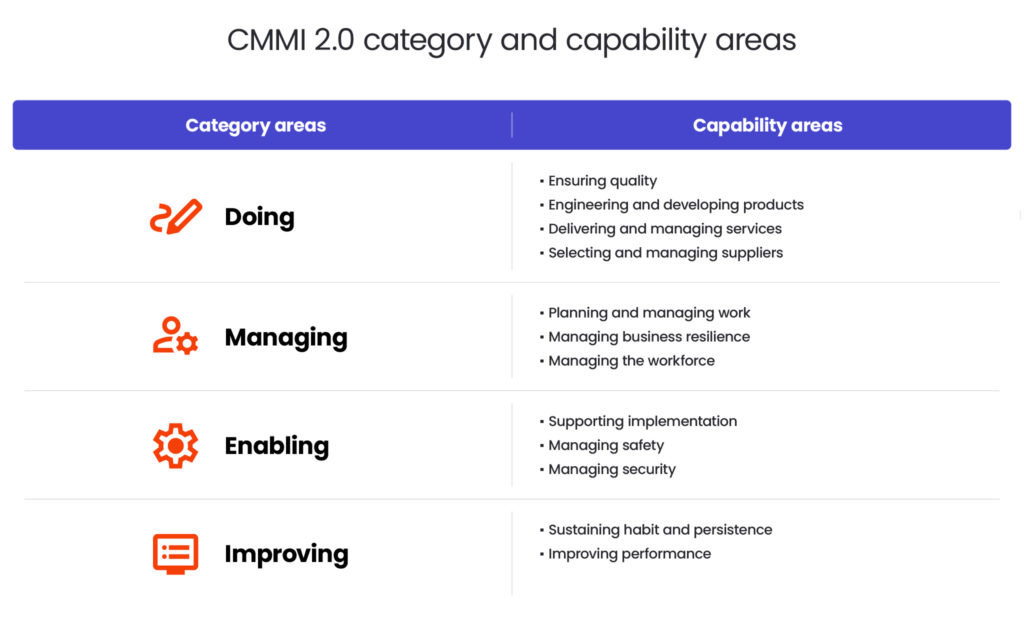What is CMMI 2.0? A guide to CMMI requirements, maturity levels and appraisal methods
For over two decades, CMMI has been used by high-performing organisations, helping them improve their processes and decrease risks in software development. If you’re also considering adopting this framework, you’ve come to the right place.
From this article, you’ll learn everything you should know about CMMI 2.0: from an overview of the Category, Capability and Practice Areas to the description of Maturity Levels and Appraisal Methods.
What is CMMI 2.0?
CMMI (Capability Maturity Model Integration) is a framework to improve the quality of software and development efficiency. It provides a set of best practices and guidelines for process improvement in a project, division or the whole organisation. It’s also used as a model for assessing the process maturity level within an organisation.
CMMI originated in 1987 and has undergone many alterations and improvements since then. CMMI 2.0 is the current version of the framework, released in 2018.
CMMI 2.0 Category Areas, Capability Areas and Practice Areas
CMMI requirements are grouped into Category Areas, Capability Areas and Practice Areas. There are four CMMI Category Areas: Doing, Managing, Enabling and Improving. Each of the Category Areas consists of defined Capability Areas, which group practices for improving performance in an organisation or a project.

Practices are organised within Practice Areas. Each Practice Area is a set of practices that collectively describe the critical activities to achieve defined intent and value. The organisation is appraised at a specific maturity level based on how well certain practices are implemented.
What are the CMMI maturity models?
CMMI defines six CMMI maturity levels:
Maturity Level 0 – Incomplete
Maturity Level 0 characterises a company in which processes are unknown or ad-hoc – they may not be followed or exist at all. At this stage, work “may or may not be completed”.
Maturity Level 1 – Initial
Maturity Level 1 means that processes are still unpredictable and reactive rather than planned and practices are not fully implemented. The work may not always be completed on time or within the budget. Businesses at Maturity Level 1 are perceived as inefficient.
Maturity Level 2 – Managed
In organisations at Maturity Level 2, processes are planned, performed, measured and controlled on a project level but not across the whole company. However, there are still some issues to address and resolve. The following Practice Areas must be implemented and rated:
- Managing Performance and Management
- Supplier Agreement Management
- Process Quality Assurance
- Configuration Management
- Monitor and Control
- Planning
- Estimating
- Requirements Development and Maintenance
- Governance
- Implementation Infrastructure
Supplier Agreement Management can be declared Non Applicable if there are no suppliers.
Maturity Level 3 – Defined
Maturity Level 3 means that the practices are followed in the whole company. Businesses at this stage understand what their areas for improvement are and have a plan to address them.
Below are listed the practices that must be implemented and rated at Level 3:
- Managing Performance and Management
- Supplier Agreement Management
- Process Quality Assurance
- Configuration Management
- Monitor and Control
- Planning
- Estimating
- Requirements Development and Maintenance
- Governance
- Implementation Infrastructure
- Causal Analysis and Resolution
- Decision Analysis and Resolution
- Organisational Training
- Risk and Opportunity Management
- Process Asset Development
- Peer Reviews
- Process Management
- Verification and Validation
- Technical Solution
- Product Integration
Supplier Agreement Management can be declared Non Applicable if there are no suppliers.
Maturity Level 4 – Quantitatively Managed
Organisations at Maturity Level 4 have a data-driven approach to process improvement. Their processes are predictable and aligned with stakeholder needs. The risk level is lower since the organisations have more insights into process deficiencies. Level 4 is considered high maturity, though few companies reach this point in practice. In the automotive environment, level 4 of CMMI is treated as an aspiration rather than an achievable goal.
In addition to practices applicable to Level 3, organisations at Level 4 must additionally use and rate:
- Managing Performance and Management at Level 4
- Planning at Level 4
- Governance
- Causal Analysis and Resolution at Level 4
- Process Management at Level 4
- Supplier Agreement Management at Level 4
Supplier Agreement Management can be declared Non Applicable if there are no suppliers.
Maturity Level 5 – Optimising
Maturity Level 5 characterises organisations that strive for continuous process improvement, which gives them a stable foundation for introducing innovation. Similarly to the previous level, Level 5 is commonly regarded as an aspiration.
In addition to Practice Areas applicable to Level 4, organisations at Level 5 must also implement:
- Causal Analysis and Resolution at Level 5
- Managing Performance & Measurement at Level 5
What is CMMI appraisal? What are the types of CMMI appraisal?
The aim of an appraisal is to find out the strengths and weaknesses in your processes based on CMMI best practices. There are 4 types of CMMI 2 appraisal methods: Benchmark, Sustainment, Evaluation, and Action Plan Reappraisal.
Let’s discuss each appraisal method in more detail:
Benchmark Appraisal
The Benchmark Appraisal identifies opportunities for process and business performance improvement. It results in a Maturity Level rating valid for 3 years.
Action Plan Reappraisal
If an organisation narrowly misses their targeted Maturity Level in a previous appraisal, they can carry out an Action Plan Reappraisal.
Sustainment Appraisal
This is done 2 years following the Benchmark Appraisal to confirm and extend its maturity level rating at a shorter time and lower cost than the Benchmark Appraisal.
Evaluation Appraisal
An Evaluation Appraisal helps to get prepared for the Benchmark Appraisal. It’s used to identify gaps and areas for improvement before the official appraisal. It’s informal and very flexible in terms of scope. An Evaluation Appraisal doesn’t result in a maturity level rating.
Is it mandatory to achieve CMMI 2.0 appraisal?
No, CMMI 2.0 appraisal is not mandatory. However, it’s worth noting that CMMI is commonly required by U.S. Government software development contracts and thus can be your significant competitive advantage.
How does an organisation benefit from adopting CMMI 2.0?
CMMI allows organisations to evaluate how their processes compare to CMMI best practices and identify areas for improvement. Also, from a client’s perspective, organisations with a high maturity level (3-4) are perceived as more reliable and stable.
It’s worth noting that CMMI is especially beneficial for organisations with short time requirements as it instructs to first map the timings and then plan the modules of the software development phase.
About the author
RECOMMENDED ARTICLES





